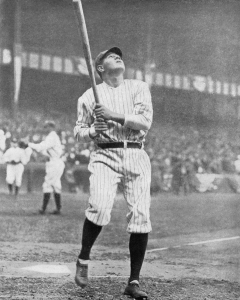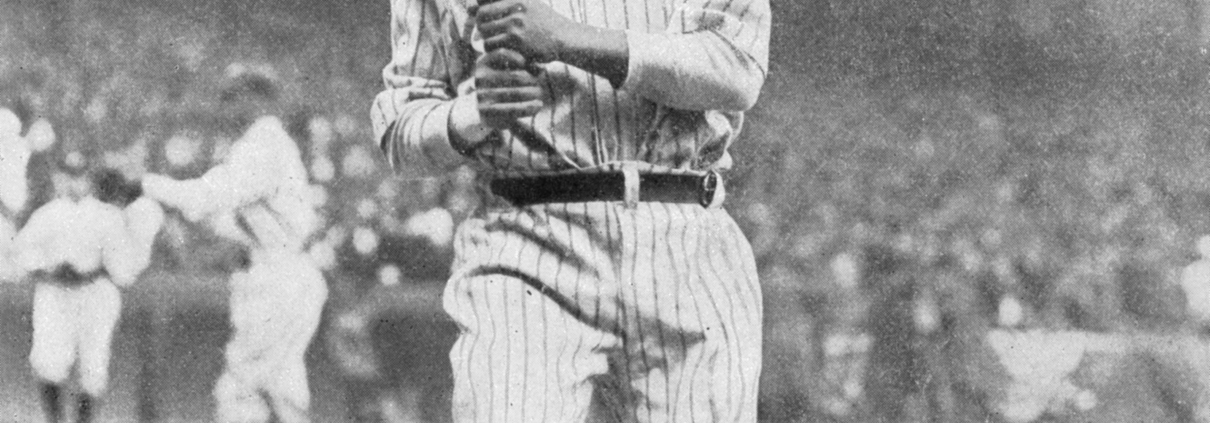May 21, 1930: Babe Ruth first to hit three home runs in a game at Shibe Park
 Babe Ruth made history on May 21, 1930, when, in the first game of a doubleheader, he became the first player to hit three home runs in a game at Shibe Park.1 Oddly enough, that’s not the primary reason why Babe is remembered for this game. Instead, he is incorrectly remembered, thanks to erroneous information in at least two of his major biographies, for something he didn’t do that day.
Babe Ruth made history on May 21, 1930, when, in the first game of a doubleheader, he became the first player to hit three home runs in a game at Shibe Park.1 Oddly enough, that’s not the primary reason why Babe is remembered for this game. Instead, he is incorrectly remembered, thanks to erroneous information in at least two of his major biographies, for something he didn’t do that day.
The Babe’s big day began in the top of the first inning, when, with one out and Lyn Lary on first base, he hit a ball over the right-field wall against George Earnshaw. Home run number two came his next time up, in the third inning. With one out, Earle Combs on second base and Lary on first, Ruth hit another homer to right, this one going ever farther. James C. Isaminger described it in the next day’s Philadelphia Inquirer:
“He drove the ball over the wall, Twentieth street, a dwelling and all, the pill finally falling down in the second street from the park for the longest circuit crack that eyes in the press box ever envisaged.”2
William E. Brandt of the New York Times was likewise impressed: “The ball soared across the first row of houses across the street from the right-field wall, diving into the back yard of a house facing on the next street.”3
The Yankees increased their lead to 6-0 in the fourth inning on another home run, this one off the bat of third baseman Ben Chapman, an inside-the-park blow that eluded A’s left fielder Al Simmons. Yankee right-hander Red Ruffing, who had been acquired from the Red Sox just two weeks earlier, held the A’s to two singles over the first three innings, but the home team got on the board in the bottom of the fifth, when Joe Boley singled in one run and a second scored on an error by New York second baseman Tony Lazzeri.
Earnshaw was removed for a pinch-hitter during that fourth-inning rally, and his replacement, 46-year-old Jack Quinn, held the Yankees scoreless over the next three innings. Ruth batted once during that time, in the fifth inning, and again hit a fly ball to right, but this time it stayed in the park and was caught by Bing Miller. Meanwhile, Jimmie Foxx knocked Ruffing out of the box with a two-run homer in the bottom of the fourth to cut the Yankees’ lead to 6-4.
Then, in the bottom of the eighth, the A’s exploded. Yankees pitcher Roy Sherid, who relieved Ruffing in the fifth, walked Simmons leading off. Foxx tripled to score Simmons, and when Miller walked, manager Bob Shawkey called on Hank Johnson to take the mound. The A’s immediately tied the game when Wally Schang hit into a fielder’s choice, Foxx scoring, and it was 6-6.
Boley singled Schang to second, and both runners advanced on a wild pitch. That brought Quinn to the plate, but with the count 2-and-2, A’s captain Eddie Collins, running the team in the absence of manager Connie Mack, who had an infected tooth,4 called on Spencer Harris to take Quinn’s place at the plate, and Harris walked to load the bases.
Max Bishop followed with a groundball to Lary at short, and when Lary’s throw to the plate in an attempt to get a force out was wild, Schang scored to put the A’s in front, 7-6. Mule Haas then bunted, and when Boley was called safe on the throw home, Yankees catcher Bill Dickey threw the ball against home plate (“in a childish display of temper,” according to one account5); the ball rolled to the A’s dugout, allowing Harris to score as well, and home-plate umpire Dick Nallin ejected Dickey. It got worse for the Yankees from there: an RBI single by Jimmy Dykes, a sacrifice fly by Simmons, and run-scoring singles by Miller and pinch-hitter Cy Perkins made it 13-6, A’s.
But the Babe wasn’t done yet. In the top of the eighth, with one out and the bases empty, Ruth hit another home run to right, this one off Lefty Grove, for his first-ever regular-season three-homer game. (He had hit three home runs in both Game Four of the 1926 World Series and Game Four of the 1928 World Series.) The crowd of more than 32,000 rewarded the Bambino with “one of the greatest ovations ever tendered any national pastimer at Shibe Park,” according to Tom Ryan of the Camden (New Jersey) Evening Courier. “Even Bing Miller’s prize-winning world’s series hit, which drove home the deciding run in the final game of [the 1929] world series with the Cubs, did not draw more applause … than the Babe’s third homer.”
That made the score 13-7 in favor of Philadelphia. Simmons drove in two with a double in the bottom of the eighth to make it 15-7, which was the final score. Ruth was denied a chance to try for a major-league-record-tying fourth homer; he was on deck when Lary popped out to end the game.
The story of Ruth’s three home runs was embellished in 1975, when University of Notre Dame history professor Marshall Smelser published his biography of Ruth, The Life That Ruth Built. Here’s how Smelser tells the story of that day:
“For the first time in a regular season game he hit three home runs in one game. … And he still had one more time at bat on a day when he was as hot as hydrogen fusion. Nobody had hit four in one game since Ed Delahanty did it in 1896. When Ruth came up in the ninth he faced the right-handed spitball pitcher Jack Quinn. Outraging reason, Ruth decided to bat right-handed against a right-hander. He took two called strikes in this unfamiliar batter’s box, then crossed over to bat left-handed – and struck out. … It was his dumbest hour.”6
Smelser’s book is not footnoted, and it’s not at all clear where he got this story. But it quickly falls apart under inspection. Ruth did not strike out in the game, nor did he come to bat after hitting his third home run; he did not bat in the ninth inning, nor did Quinn pitch in the ninth. Ruth did face Quinn in the game: in the fifth inning, when he flied out.
None of the accounts of the game in the Philadelphia Inquirer, New York Times or The Sporting News mention Ruth attempting to bat right-handed at any point in the game, something you think might have caught their writers’ attention. In fact, there is no evidence this allegation ever appeared in print anywhere before Smelser’s book was published. Perhaps Smelser heard the tale from one of the many former teammates of Ruth he interviewed.
But Smelser’s book is still considered one of the most significant biographies of Ruth, and as a result the yarn about Ruth batting right-handed also appears in Leigh Montville’s best-selling 2006 bio, The Big Bam.7 And as this was written in 2019, the claim that Ruth swung right-handed after hitting three home runs still appeared on several online baseball history sites, including Baseball-Reference.com, TodayInBaseballHistory.com and NationalPastime.com.
In the second game of the May 21 doubleheader, Ruth was held to a single in a 4-1 A’s win. But he repeated his three-homer performance the next day at Shibe – only it took him two games to do it. He hit two homers in the first game of the doubleheader and another in the nightcap.
SOURCES
Full play-by-play of this game is on Retrosheet.org. Newspaper accounts of the game were accessed via Newspapers.com, the New York Times digital archive and Paper of Record (for The Sporting News).
NOTES
1 There were 20 later occasions on which a player hit three or more homers in a game at Shibe Park (or under its later name, Connie Mack Stadium), including Ruth’s teammate Lou Gehrig the day after Ruth did it. Gehrig (1932) and Pat Seerey of the White Sox (1948) each hit four home runs in a game at Shibe. baseball-reference.com/tiny/XLxuF.
2 James C. Isaminger, “Ruth Slams 3 Homers in First, But 9-Run Rally Wins Battle,” Philadelphia Inquirer, May 22, 1930: 18.
3 William E. Brandt, “3 Homers by Ruth Fail to Save Yanks,” New York Times, May 22, 1930: 21.
4 Tom Ryan, “Athletics and Yankees Renew Hostilities Today at Shibe Park in Second Double-header,” Camden (New Jersey) Evening Courier, May 22, 1930: 22.
5 Ryan.
6 Marshall Smelser, The Life That Ruth Built: A Biography (Lincoln: University of Nebraska Press, 1993): 422.
7 Leigh Montville, The Big Bam: The Life and Times of Babe Ruth (New York: Doubleday, 2006): 312.
Additional Stats
Philadelphia Athletics 15
New York Yankees 7
Game 1, DH
Shibe Park
Philadelphia, PA
Box Score + PBP:
Corrections? Additions?
If you can help us improve this game story, contact us.


